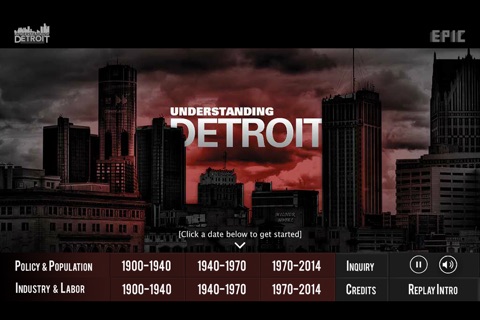
Understanding Detroit app for iPhone and iPad
A COMPLETE CURRICULUM MODULE
Provides a succinct yet broad history of 20th Century Detroit and asks students to apply the 5 habits of mind in response. It includes dramatic historical facts, current opinions and review questions that can prompt students to perform additional research, engage in discussion and complete writing projects.
The 5 Habits of Mind:
• Significance (why it is important)
• Perspective (what is the point of view)
• Evidence (how do you know)
• Connection (how does it apply)
• Supposition (what if it were different)
TARGET GRADE LEVEL: 9-12
WHATS INSIDE
• An interactive historical overview of Detroit
• Video Interviews
• Review questions based on the 5 habits of mind
• All Printable pages
COST AND SECURITY
• Free to use and share
• No In-App purchases
• No personal data collected
SUPPORTS THESE COMMON CORE STANDARDS FOR ENGLISH LANGUAGE ARTS > HISTORY/SOCIAL STUDIES Grades 9-12
Key Ideas and Details 9-11:
CCSS.ELA-LITERACY.RH.9-10.1
Cite specific textual evidence to support analysis of primary and secondary sources, attending to such features as the date and origin of the information.
CCSS.ELA-LITERACY.RH.9-10.2
Determine the central ideas or information of a primary or secondary source; provide an accurate summary of how key events or ideas develop over the course of the text.
CCSS.ELA-LITERACY.RH.9-10.3
Analyze in detail a series of events described in a text; determine whether earlier events caused later ones or simply preceded them.
Integration of Knowledge and Ideas 9-11:
CCSS.ELA-LITERACY.RH.9-10.7
Integrate quantitative or technical analysis (e.g., charts, research data) with qualitative analysis in print or digital text.
CCSS.ELA-LITERACY.RH.9-10.9
Compare and contrast treatments of the same topic in several primary and secondary sources.
Key Ideas and Details: 11-12
CCSS.ELA-LITERACY.RH.11-12.1
Cite specific textual evidence to support analysis of primary and secondary sources, connecting insights gained from specific details to an understanding of the text as a whole.
CCSS.ELA-LITERACY.RH.11-12.2
Determine the central ideas or information of a primary or secondary source; provide an accurate summary that makes clear the relationships among the key details and ideas.
CCSS.ELA-LITERACY.RH.11-12.3
Evaluate various explanations for actions or events and determine which explanation best accords with textual evidence, acknowledging where the text leaves matters uncertain.
Integration of Knowledge and Ideas 11-12:
CCSS.ELA-LITERACY.RH.11-12.7
Integrate and evaluate multiple sources of information presented in diverse formats and media (e.g., visually, quantitatively, as well as in words) in order to address a question or solve a problem.
CCSS.ELA-LITERACY.RH.11-12.8
Evaluate an authors premises, claims, and evidence by corroborating or challenging them with other information.
CCSS.ELA-LITERACY.RH.11-12.9
Integrate information from diverse sources, both primary and secondary, into a coherent understanding of an idea or event, noting discrepancies among sources.
ACCOMMODATES THE FOLLOWING LEARNING STYLES:
• Visual (spatial):pictures, images, and spatial understanding.
• Verbal (linguistic): speech and writing.
• Physical (kinesthetic): touch - interactivity.
• Logical (mathematical): logic, reasoning and systems.
• Social (interpersonal): group learning.
• Solitary (intrapersonal): self-study.
ABOUT THE CREATORS
Kendall College of Art and Design of Ferris State University (KCAD) faculty and students performed extensive research to create this media as part of the EPIC project. The Development (coding) for the Fast Food Frenzy game was powered by the the KCAD Framework created by Digital Concierge.



